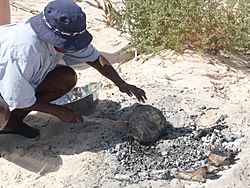Bush bread facts for kids

Aboriginal millstone – vital in making flour or pastes for bread. Some Aboriginal groups call it "mother and child"
|
|
| Alternative names | Seedcakes |
|---|---|
| Type | Bread |
| Place of origin | Australia |
| Region or state | Aboriginal |
| Main ingredients | Flour (from various seeds), water |
Bush bread is a special type of bread made by Aboriginal Australians. They made it by crushing seeds into a dough, then baking it. This bread was full of protein and carbohydrate. It was a very important part of their traditional diet.
Sometimes, bush bread is called seedcakes. You might also hear it called damper. However, damper usually refers to bread made by non-Indigenous people.
When Europeans arrived in Australia, they brought pre-milled white flour. Because of this, the traditional way of making bush bread almost disappeared. But even in the 1970s, some women in Central Australia were still making seedcakes. Today, cooking bread in hot coals is still a tradition.
Making bread was usually a job for women. It was hard work, so often several women would do it together. They would gather seasonal grains, legumes, roots, or nuts. Then they would prepare these into flour and dough. One common ingredient was the seeds of kangaroo grass.
Contents
Making Bush Bread from Seeds
Gathering the Seeds

The types of seeds used for bush bread changed with the seasons. They also depended on where people lived in Australia. In Central Australia, people often used native millet (Panicum decompositum or Panicum australianse). Spinifex (Triodia) was also common. Wattleseed could be added to the flour mix too.
Women collected dry, ripe seeds by hitting the grass or trees with sticks. This made the seeds fall off. Some seeds were eaten when they were still green. When ground, they would make a juice that people drank.
Some seeds, like those from acacia trees, needed to be heated and shelled first. Then they were ground dry. Other seeds, like those from grasses, could be ground with water.
In the Kimberley region of Western Australia, women noticed something clever. After the dry season, many seeds gathered around harvester ants' nests. The ants had already collected and husked the seeds for them! This made the women's job much easier. After the grain dried, they could start making flour.
Other Seeds Used
Many different seeds were used for bush bread. Some examples include:
- Pigwig (Portulaca oleracea)
- Prickly wattle (Acacia victoriae)
- Mulga (Acacia aneura)
- Dead finish seed (Acacia tetragonophylla)
- Bush bean (Rhyncharrhena linearis)
Making the Flour and Dough
After gathering the grain, it needed to be winnowed. This means separating the seeds from the husks. Women used a coolamon, which was a multi-purpose carrying dish, for this. Sometimes, they had to winnow the grain several times.
Once clean, the grain was ground into flour using a millstone. Some millstones found are as old as 50,000 years! The flour was then mixed with water to make a dough. This dough was baked in hot ashes. The result could be small buns, now called johnny cakes. Or it could be a large loaf, known as damper. Damper seems to be a mix of traditional Aboriginal and European bread-making styles.
Sometimes, the dough was eaten raw. Baking the bread was a good idea if the group was going to travel for a while.
Bush Bread from Other Plants
Bush bread could also be made from plant roots and corms. In the Top End of Australia, people like the Yolngu used lotus root and wild taro. They would grind these plants, mix them into a paste, and then make bread.
Water lily seed bread was also popular in the Top End. Two types of water lily were used: Nelumbo nucifera and Nymphaea macrosperma. During the early dry season, water lilies were a key food. Their seed pods were eaten raw or ground into a paste.
Aboriginal women had amazing knowledge about how to make certain plant foods safe to eat. For example, the seeds of the cycad palm, Cycas media, are very harmful when raw. They need a lot of treatment. This includes shelling, crushing, and soaking them in running water for up to five days. Then they are cooked. After all this, they are made into small loaves that can last for weeks.
In Queensland, people in the Mount Tamborine area used the bunya pine cone (bunya nut) to make bread. This tree is native to that area.
The Burke and Wills Expedition
The famous explorers Burke and Wills ate bush bread for some time. This was after they ran out of their own food because their camels died. The Yandruwandha people, who were Aboriginal people from Cooper Creek, gave them fish, beans called padlu, and bread. This bread was made from the ground sporocarps of the ngardu (nardoo) plant (Marsilea drummondii).
Some people think that the nardoo might have contributed to their deaths. Wills' last diary entry mentioned that eating nardoo for starvation was not unpleasant, but it made him very weak. He felt that fat and sugar were more important for survival in Australia.
It is thought that Burke and Wills did not prepare the nardoo bread in the traditional Aboriginal way. Aboriginal people knew to soak the seeds before grinding them. This removes an enzyme called thiaminase. This enzyme takes away vitamin B1 from the body. So, it is believed that Burke and Wills' deaths were partly due to the vitamin deficiency disease beri-beri. However, other research suggests that scurvy (a vitamin C deficiency) and the harsh environment also played a part in their deaths.
Images for kids
See also
 In Spanish: Bush bread para niños
In Spanish: Bush bread para niños



